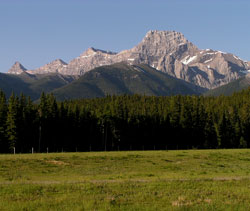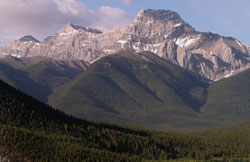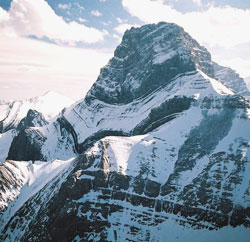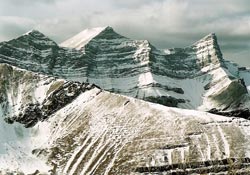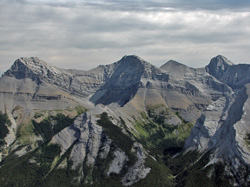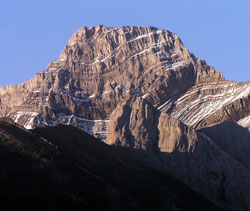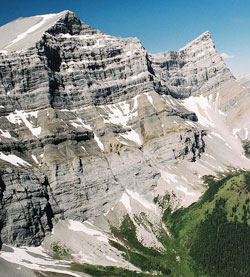
Photo: Looking south to the northwestern most peak of Mount Lougheed from the Trans-Canada Highway
Mount Lougheed
- 3105 m (10,188ft)
- First Ascent
- Naming History
Located east of Spray Lakes Reservoir at the head of Wind Creek
Province: Alberta
Park: Kananaskis
Headwater: Bow
Visible from Highway: 1
Ascent Party: W.S. Drewry, A. St. Cyr
Ascent Guide: Tom Wilson
Named for: Lougheed, Hon. Sir James (James Lougheed was a prominent Calgary lawyer and politician. He practiced law with R.B. Bennett and later became a senator and cabinet minister.)
Mount Lougheed has three summits. The northwest summit (3080 m) is the spectacular one and the one generally referred to as Mount Lougheed from the Trans-Canada Highway viewpoint. However the middle summit (3105 m) is the highest and the southeastern summit (3010 m) is the lowest. Wind Mountain (3153 m) is the next peak to the southeast and is higher than any of the summits of Mount Lougheed. A classic peak, the gently folded strata of Mount Lougheed's northern cliffs are often highlighted by snow which lingers on the narrow ledges which stretch across the steep face. W.S. Drewry and A. St. Cyr claimed the first ascent of Mount Lougheed but this was disputed in later years by Tom Wilson, the most famous of the early packers and outfitters of Banff National Park and the first non-native to reach the shores of Lake Louise. He claimed to have made the first ascent two days prior to Drewry and St. Cyr. All three were in the employ of James McArthur at the time assisting the surveyor as he conducted a survey for the CPR. The Palliser Expedition was travelling up the Bow Valley in 1858 when Eugene Bourgeau, the expedition's botanist, first saw the magnificent mountain which dominates the panorama from Dead Mans Flat. It must have been just as much of a surprise to him as it can be to those who now travel up the Bow Valley by car on the Trans-Canada Highway. Clouds were swirling around the summit and so he named it Wind Mountain. He ascended some nearby slopes and to his delight was able to collect about fifty varieties of alpine plants. Unlike some others of the era, when Bourgeau got a chance to name a peak he preferred to choose a name based on a natural feature rather than use the name of a famous person who more often than not would never even see the peak. But some seventy years later a decision was made that this was too spectacular a peak to have the simple name of "Wind." Sir James Lougheed had recently passed away and it had been decided that a mountain west of Calgary should be named in his honour. Lougheed had practiced law in the city in partnership with the future prime minister of Canada, R.B. Bennett. Sir James had been appointed to the senate and later became a privy councillor and cabinet minister in Robert Borden's government. A mountain near Healy Creek in Banff National Park was chosen to carry the name of Sir James Lougheed. However the Lougheed Family did not approve of this particular peak and, perhaps assisted by R.B. Bennett, successfully exerted pressure in the right places to have the much more spectacular Wind Mountain renamed Mount Lougheed in 1928. Sir James Lougheed's grandson Peter was Premier of Alberta in the 1970's and early 1980's and during his time in office succeeded, with other members of his family, in climbing the mountain with guides. However the renaming of the mountain was not the end of the name "Wind." The impressive peak to the south of Mount Lougheed and quite similar in elevation was named Wind Mountain in 1985. So there still is a Wind Mountain in the panorama but it is not the mountain which Eugene Bourgeau named Wind Mountain in 1858. To further complicate matters, the steep-cliffed mountain to the right of Mount Lougheed is known as Windtower and the ridge immediately southwest of Dead Man's Flat is called Wind Ridge.
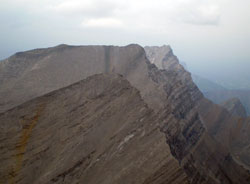
Looking northwest from Wind Mountain to the three summits of Mount Lougheed (courtesy Phil Schreiner)

Looking west-southwest to Wind Mountain (left) and the three summits of Mount Lougheed from Mount Collembola (courtesy Calvin Damen)

Looking northeast to the north peak of Mount Lougheed from the Smith-Dorrien Road (courtesy Calvin Damen)
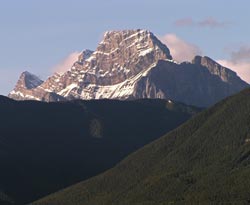
Looking southeast across Wind Ridge to Mount Lougheed with Wind Mountain to left and Windtower at right
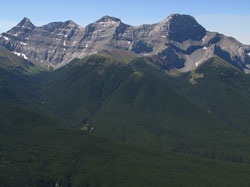
Looking southwest to Wind Mountain (left) and Mount Lougheed (the other three peaks) (courtesy Rob Taerum)
